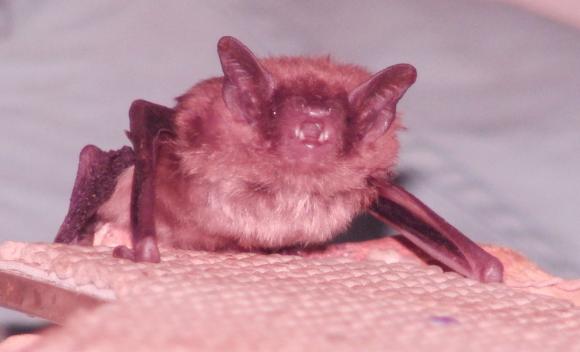PROVIDENCE, R.I. [Brown University] — In a paper published this week in Science, researchers at Brown University and from the Republic of Georgia have learned how bats can home in on a target, virtually dismissing other objects in their midst. The trick lies in their neurons: Bats can separate a cavalcade of echoes returning from their sonar blasts by distinguishing changes in amplitude — the intensity of the sound — between different parts of each echo within 1.5 decibels, to decide whether the object is a target or just background clutter.
The minute change in amplitude is enough to cause a delay in the bats’ neural response to an echo, letting the bat know what is clutter and what is target. It is as if the bat is using two screens — a main screen that keeps it locked in on its target by virtue of its neural response to the echo and another, secondary screen that keeps note of surrounding objects but doesn’t fixate on them.
Bat harmonics
The National Science Foundation produced this video on the work of James Simmons and Mary Bates
“Everything the bat sees using sonar is based on the timing of the neural responses and nothing else,” said James Simmons, professor of neuroscience at Brown and an author on the paper.
The research is important because it could help refine the maneuverability of sonar-led vehicles and improve their ability to remain fixed on a target even in dense, distracting surroundings.
In a paper in the Proceedings of the National Academy of Sciences last year, Simmons and Mary Bates, who studied under Simmons and earned her doctorate last May, showed how bats avoid colliding with objects while flying in tight quarters. The key, they determined, is that bats tweak their sounds (chirps) and thus the echoes they receive to differentiate one broadcast/echo set from another. Building on that research, Bates and Simmons sought to determine how bats take note of objects in their sonar surroundings without being deterred by them — how bats prioritize the clutter of echoes.
“The problem the bat is facing is that it’s flying around in this really complicated environment. It’s getting all these echoes back [from the sonar broadcasts it emits], and the echoes are all arriving at almost the same time,” said Bates, lead author on the Science paper. “And they have no trouble at all dealing with that. We're trying to figure out perceptually how these bats distinguish an echo from a nearby target from all the background echoes that are arriving within a similar time window.”
In a series of experiments, the researchers studied those times when the bats would encounter a “blind spot,” when the echoes were so close together that the bat could not distinguish its target from the surrounding clutter. The range in which the bats can detect when one echo interferes with another is a mere 50 milliseconds, the researchers report.
Harmonics plays a major role. Bat chirps — sounds — generally have two harmonics. When a bat chirps, it waits for the corresponding echo. It makes a mental fingerprint of the emitted sound and its echo; if the broadcast/echo fingerprints match up precisely, then the bat “will process it and produce an image,” Simmons said. In many cases, that image is an object it is targeting. But when the second harmonic is weaker in the echo fingerprint, the neurons’ response is delayed by as few as 3 microseconds. That delay, while undetectable to humans, is enough to tell the bat that the object is present, but it is not its primary interest.
“What the bat does is it takes clutter and defocuses it, like a camera would, so the target remains highly defined and in focus,” Simmons said.
Tengiz Zorikov from the Institute of Cybernetics in the Republic of Georgia contributed to the research. The U.S. Office of Naval Research, National Institutes of Health, and the National Science Foundation funded the work.

